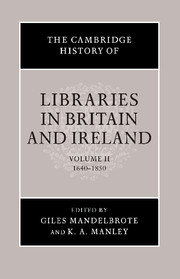Book contents
- Frontmatter
- 1 Introduction: the changing world of libraries – from cloister to hearth
- PART ONE THE EXPANSION OF BOOK COLLECTIONS 1640–1750
- 2 Ancients and moderns: cross-currents in early modern intellectual life
- 3 Libraries, books and learning, from bacon to the enlightenment
- 4 Opportunities for building collections and libraries
- 5 Libraries for school education and personal devotion
- 6 Libraries for the parish: individual donors and charitable societies
- 7 Endowed libraries for towns
- 8 Libraries in university towns
- 9 Ecclesiastical libraries: libraries for the higher clergy
- 10 Libraries for antiquaries and heralds
- 11 Professional collections: libraries for scientists and doctors
- 12 Personal owners of books
- 13 Library buildings and fittings
- 14 Baroque librarianship
- PART TWO LIBRARY DEVELOPMENT AT A LOCAL LEVEL
- PART THREE PROVINCIAL AND METROPOLITAN LIBRARIES 1750–1850
- Select bibliography
- Index
- References
2 - Ancients and moderns: cross-currents in early modern intellectual life
from PART ONE - THE EXPANSION OF BOOK COLLECTIONS 1640–1750
Published online by Cambridge University Press: 28 March 2008
- Frontmatter
- 1 Introduction: the changing world of libraries – from cloister to hearth
- PART ONE THE EXPANSION OF BOOK COLLECTIONS 1640–1750
- 2 Ancients and moderns: cross-currents in early modern intellectual life
- 3 Libraries, books and learning, from bacon to the enlightenment
- 4 Opportunities for building collections and libraries
- 5 Libraries for school education and personal devotion
- 6 Libraries for the parish: individual donors and charitable societies
- 7 Endowed libraries for towns
- 8 Libraries in university towns
- 9 Ecclesiastical libraries: libraries for the higher clergy
- 10 Libraries for antiquaries and heralds
- 11 Professional collections: libraries for scientists and doctors
- 12 Personal owners of books
- 13 Library buildings and fittings
- 14 Baroque librarianship
- PART TWO LIBRARY DEVELOPMENT AT A LOCAL LEVEL
- PART THREE PROVINCIAL AND METROPOLITAN LIBRARIES 1750–1850
- Select bibliography
- Index
- References
Summary
When Jonathan Swift decided to take stock of the intellectual culture of his time, he did so by taking sides in the great quarrel between the ancients and the moderns that had been gradually coming to a head for more than a century. It was natural for him to adopt the cause of his patron, Sir William Temple, and see what could be done to defend the allegiance to antiquity that Temple had argued in a brief but provocative essay that started the argument in 1690. What Temple had done there was to assert that every great cultural achievement lay in the past and that the best hope of the moderns was simply to acknowledge and imitate them. This was an old argument but it was especially provocative after a tumultuous century of modern accomplishment and Temple was answered at once, particularly by William Wotton and the defenders of the new science in the Royal Society. Thus began the battle of the books which Swift described and resumed in his own little work – and which he set appropriately enough in a library.
To make sense of that noisy quarrel, one must look past its more frivolous moments to discover its foundation in a clash of cultural ideals, deeply rooted in European history. In particular, there were reflected in it two different attitudes that had come into conflict almost from the beginning of ancient times and which were often to be resumed in later generations. On the one hand, there was a philosophical/theological ideal that taught that the highest end of culture was to understand the unchanging principles of the natural and supernatural worlds.
- Type
- Chapter
- Information
- Publisher: Cambridge University PressPrint publication year: 2006



